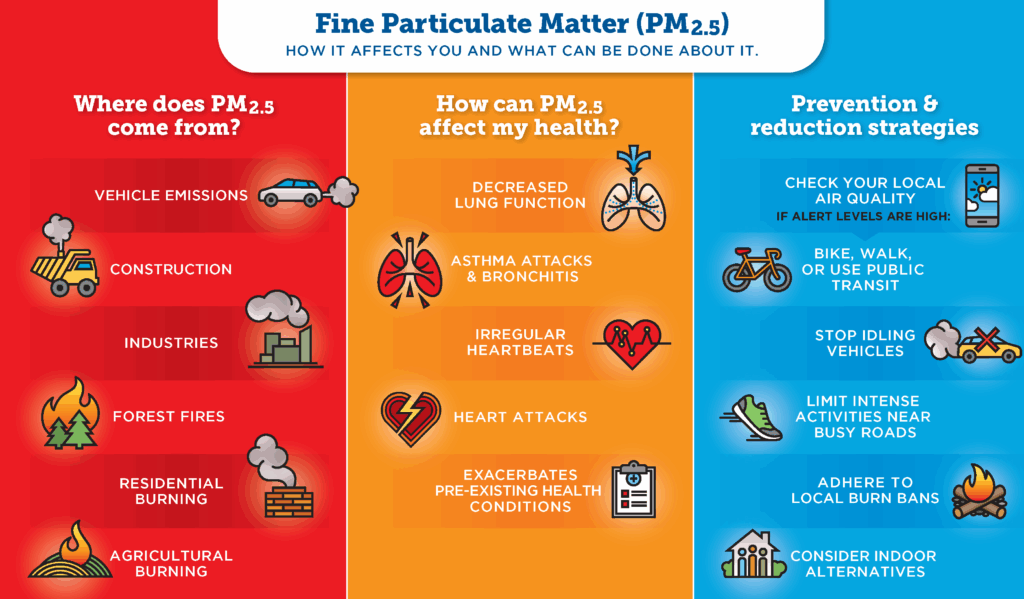Every breath we take connects us to the atmosphere surrounding our planet. But what exactly are we inhaling? Let’s break down the composition of air pollution and its effects on our health and environment.
Primary Pollutants: Direct Emissions
Primary pollutants enter our atmosphere directly from their sources. These harmful substances originate from both human activities and natural processes:
- Sulfur Dioxide (SO₂)
- Released primarily through burning coal and oil, sulfur dioxide irritates the respiratory system and can significantly worsen asthma symptoms. Power plants and industrial facilities are major contributors of this gas.
- Nitrogen Oxides (NOₓ)
- These gases emerge from the exhaust of vehicles, airplanes, and power plants. Beyond their direct health effects, nitrogen oxides play a critical role in forming smog and fine particulate matter that compromise our ability to breathe normally.
- Carbon Monoxide (CO)
- This invisible threat, colorless and odorless, comes from incomplete combustion in cars, wood stoves, and fires. Carbon monoxide’s danger lies in its ability to bind with hemoglobin in our blood, reducing oxygen transport throughout the body. This poses risks for people with existing heart conditions.
- Volatile Organic Compounds (VOCs)
- From vehicle exhaust to everyday products like cleaning solutions and paints, VOCs are common in modern life. These compounds readily evaporate at room temperature and contribute to both indoor and outdoor air pollution.
- Particulate Matter (PM)
- These tiny solid and liquid particles suspended in air originate from diesel engines, construction sites, and wildfires. Their small size allows them to penetrate deeply into our respiratory system, causing serious damage to our lungs and heart.
Secondary Pollutants: Chemical Reactions in the Atmosphere
When primary pollutants interact with sunlight, water vapor, and other elements in the atmosphere, they create secondary pollutants:
- Ozone (O₃)
- While stratospheric ozone protects us from harmful UV radiation, ground-level ozone is a major component of smog. It forms when VOCs and nitrogen oxides react in the presence of sunlight. For people with asthma and other respiratory conditions, ozone can trigger serious breathing difficulties.
- Photochemical Smog
- The brownish haze often visible over cities like Los Angeles results from sunlight-driven reactions between pollutants. This complex mixture creates the characteristic thick air that reduces visibility and harms respiratory health.
- Acid Rain
- When sulfur dioxide and nitrogen oxides combine with atmospheric water vapor, they form sulfuric acid (H₂SO₄) and nitric acid (HNO₃). These compounds return to Earth as acid rain, damaging plant life, eroding buildings, and contaminating water sources.
- Sulfurous Smog
- Sometimes called “London smog” after the deadly 1952 event that claimed thousands of lives, this pollution occurs when high levels of sulfur compounds from coal burning mix with fog, creating a dangerous, thick pollution blanket.
Understanding Particulate Matter: Size Matters
The health impact of particulate pollution largely depends on particle size:
PM10 (10 micrometers or less)
Sources
- Natural: Dust storms, pollen, mold spores
- Human-made: Construction sites, landfills, agricultural activities, vehicle exhaust
Health Impacts
These particles can cause respiratory issues and worsen existing conditions like asthma.

PM2.5 (2.5 micrometers or less)
Sources
- Natural: Forest fires, volcanic eruptions
- Human-made: Motor vehicles, power generation, wood burning, agricultural practices
Health Impacts
These fine particles penetrate deeply into the lungs and can enter the bloodstream, causing heart attacks, decreased lung function, and aggravated respiratory symptoms. Long-term exposure is linked to lung cancer and premature death.
Ultrafine Particles (less than 0.1 micrometers)
Sources
- Natural: Ocean spray, soil erosion
- Human-made: Diesel and gasoline engines, industrial processes
Health Impacts
Their extremely small size allows these particles to pass through lung tissue into the bloodstream and reach other organs. With larger surface areas relative to their size, they can carry more toxic compounds. Research links them to cardiovascular and respiratory illnesses, as well as various cancers.